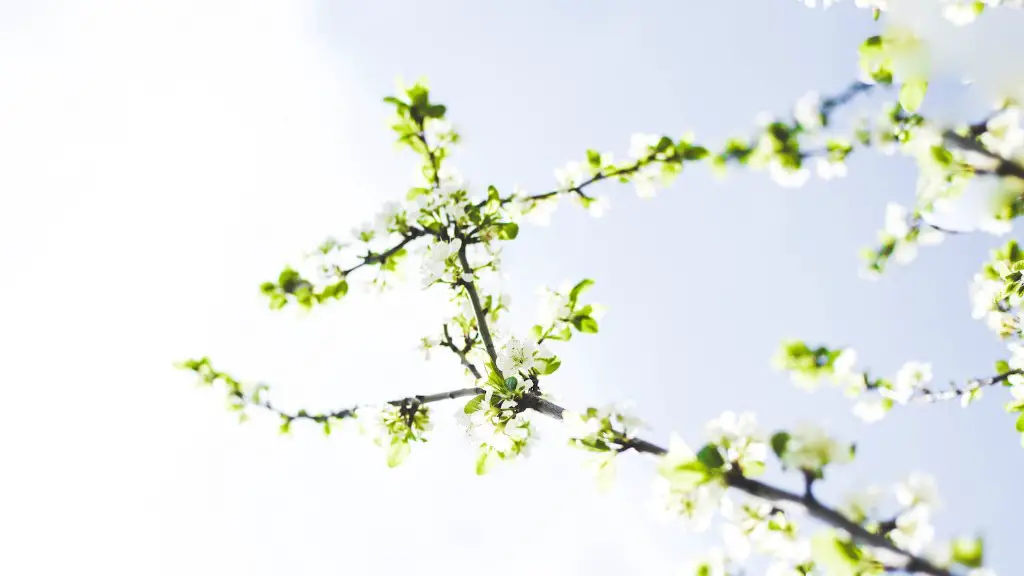Supplies Needed for Planting a Cherry Tree
Prior to planting, it’s important to ensure all the necessary supplies are collected in order to ensure a successful planting session. The basics for planting a cherry tree include a shovel for digging, quality potting soil, a pot for growing when necessary, mulch for insulation, and a garden hose for watering. All of these items can easily be found at any local hardware store.
Select the Proper Location
In order to make sure the cherry tree thrives and grows, it’s important to select the best location possible to place the tree. Cherry trees should be planted in areas with full sun exposure, allowing for at least six to eight hours of sunlight per day. Although shallow soil is acceptable, a deeper soil bed is an ideal environment for a cherry tree, providing more robust root structure. Soil beds with a drainage system are preferred to prevent water logging. If a tree is being grown in a pot, this should also be placed where there is plenty of sunlight.
Digging
Now that a good location has been identified, it’s time to dig the hole for planting. A hole should be about two feet deep for a bare-root tree, and three feet deep for a potted tree. If planting more than one tree, leave at least ten feet of space between them. Digging the hole is the most labor-intensive part of planting a cherry tree. For an efficient and quality job, the soil should be removed in sections, three to four inches at a time, then tilling the soil by hand or power so that it becomes light and well aerated. When finished, the hole should be twice as large as the root-ball of the tree.
Filling the Hole
Next comes the process of filling the hole. Start off by placing a one-inch layer of the soil mixture in the bottom of the hole to aid drainage. Then place the tree in the hole, and make sure to evenly spread out the roots as you start to fill it in with the soil. As you begin to fill in the hole, press the soil down gently so it’s packed firmly in place around the roots. When there’s only a couple inches of soil left, create a sunken collar around the outer edge of the tree, to ensure that moisture remains within the tree’s root-zone.
Watering
Once the tree is planted, it must be watered immediately. A thorough soak should be given to the entire root zone. To conserve water, the tree could alternatively be watered using a hose fitted with a ‘weep’ nozzle. The weep nozzle ensures a steady and slow drip of water, allowing the tree to properly absorb the water. Watering the tree for about 15 minutes, two to four times per week is the recommended amount for a cherry tree.
Mulching and Fertilizing
A two to three inch layer of organic mulch should be applied around the base of the tree, as this helps with insulation as well as controlling weeds and soil erosion. For fertilizer, use a ‘starter’ fertilizer about two inches away from the tree, according to manufactures instructions. Two to three months after planting, fertilizer can then be added in the form of bone meal. This helps to create strong roots and encourage growth.
Pruning
Pruning helps to shape a cherry tree and can be done in the autumn or early winter while the tree is still dormant. Cutting off any dead or diseased limbs is recommended in order to avoid any further harm to the tree. Pruning also promotes a healthy and attractive tree shape, while improving air circulation and fruit spur production. This generally requires minimal pruning.
Pest and Disease Control
Cherry trees are generally more tolerable to pests and diseases Thanks to the high antioxidant content most cherry trees possess. In order to keep pests and diseases from occurring, frequent spraying of diluted neem oil, a natural plant oil, is recommended. For insect control, various types of beneficial insects such as ladybugs, green lacewings, and praying mantis can be deployed to keep unwanted pests away.
Improving Soil Quality
In order for a cherry tree to reach maturity, excellent soil quality is essential. Ensuring a balanced acidity and mineral content creates better healthy soil, which is beneficial for cherry tree growth. Testing the soil’s pH level with a simple pH test kit will give an indication of the acidity or alkalinity in the soil. Drainage is also an important factor to consider, as dry or wet soil can have an effect on the growth and health of the tree.
Soil Amendments
To improve the quality of soil and increase the fertility, adding organic materials such as compost or manure is recommended. Organic materials should be well worked into the soil, and can enrich the soil in terms of its minerals and nutrients. Also, a slow-release fertilizer can be applied into the soil prior to planting. This type of fertilizer delivers energy for slow, but steady growth for the cherry tree throughout the season.
Maintaining a Healthy Environment for Growth
In order for a cherry tree to thrive and reach its full potential, an adequate environment needs to be maintained at all times. This includes ensuring that its soil has the necessary minerals and nutrient content, sufficient water levels are present, pH levels are correctly balanced, and pests and disease are kept at bay. These considerations are at the heart of proper cherry tree care and maintenance, and will result in happier and healthier cherry trees.


